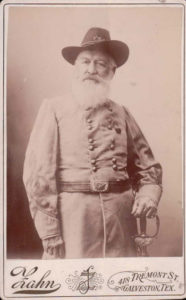
Brigadier General Thomas N. Waul modeled his Confederate uniform shortly before his retirement from law practice in Galveston in 1893. He and his family moved to Cherry Hill, east of Greenville where he began a new career in his successful orchards at age ninety.
Cherry Hill was the last home of Brigadier General Thomas Neville Waul and his wife Mary America Simmons. The farm was located seven miles east of Greenville, producing a wide variety of delicious fruits in a region not known as an orchard.
General Waul was born in January 1813 in Sumter District of South Carolina and studied law in Vicksburg. In 1837 he married Mary America Simmons in Mississippi. He continued to practice law there until 1850 when the couple moved to Gonzales County, Texas. Since Gonzales County was near the Texas frontier at that time, Waul saw the need for frontier defense.
Sometime within the next decade Thomas and Mary America Waul moved to Galveston where he became a noted and respected maritime attorney. They became members of the most prominent groups of Galveston society. When the Civil War began, Waul became supportive of defense along the Texas frontier, but was not able to convince other Confederates of the need.
In the spring of 1862 Thomas N. Waul organized and funded a Legion, a military unit composed of infantry, cavalry, and artillery components. Known as Waul’s Legion, the 2,000 member unit trained at Brenham before moving east to cross the Mississippi River. Waul was determined to defend his beloved Vicksburg. The task of commanding such a military group was very difficult. Waul and all of his men, except for one cavalry company out on patrol, surrendered on July 4, 1863.
Later that summer, Waul and his men were pardoned. They reorganized that fall in Houston where they served under General E. Kirby Smith in the Red River Campaign. Waul led his men in battle at Mansfield, Louisiana and Jenkins’ Ferry, Arkansas.
Thomas N. Waul again surrendered in May 1865. He applied for amnesty that he received on December 6, 1865. At that time he signed the Oath of Allegiance to the United States in front of A. J. Hamilton, Provisional Governor of Texas.
Waul returned to his law practice then. He continued to practice in Galveston until retirement in 1893 at the age of eighty. At that time, he, his wife, her brother and two more relatives arrived in Greenville to try farming; not just any kind, but growing fruits. Hence, the name Cherry Hill. General Waul built a lovely home with wide porches looking out over his fruit trees. He had a small office built in the yard where he greeted neighbors, old friends, and new acquaintances.
Brigadier General Thomas N. Waul, C. S. A., died on the 28th of July 1903.
His funeral was held in the District Court room of the Hunt County Courthouse, the largest meeting place in the county. The body was taken down Lee Street to the Katy Depot for the last trip to Fort Worth. Waul and his wife, who died a year later, are buried at Oakwood Cemetery there.
In 1936 the State of Texas decided to honor Confederate Generals from Texas with large granite stone and bronze markers. The one for General Waul is now located at the site of Cherry Hill.

So where exactly is the Cherry Hill granite marker????
7 miles east doesn’t get me an exact location. I heard FM 2736, but don’t see it.
The Hunt County Historical Commission website mentions that it’s on a “County road south of FM 2736, east of Greenville”, which makes for a lot of slow driving and searching. The website also mentions that this was one of the 1963 Civil War markers, so if my poor memory serves me, this could be flush against the ground, as opposed to one of those wonderful 1936 granite markers that usually are hard to miss (and which is specified in the last paragraph, leaving us a little conflict :).
Carol, are you out there?
The house was still standing in the 1980s before it got pushed over, burned, and buried by a new owner of the land. A shame since it probably could of been restored. There was a separate small library building and that was actually moved from its original location.